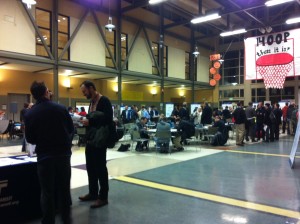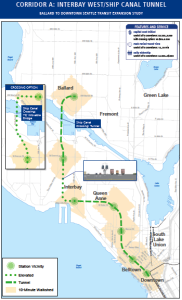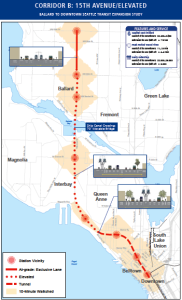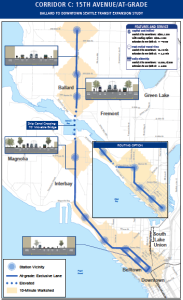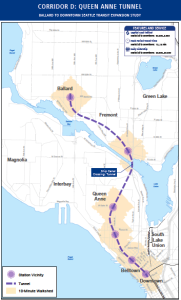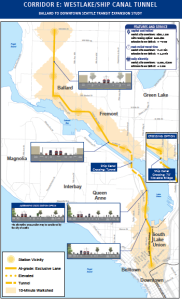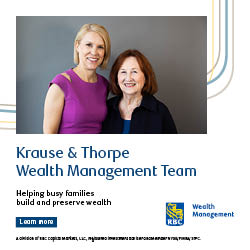The final Ballard to Downtown Transit Expansion Study Open House was well attended by locals last Thursday night at Ballard High School. Attendees had the opportunity to view, discuss and give feedback on the five final corridor options that have been narrowed down through investigation by the project team and community feedback from the previous open house events.
Sound Transit and the City of Seattle started their partnership on the project on a conceptual level early this year to study rail transit improvements between Ballard and Downtown. Although any potential future transit extensions would be subject to Sound Transit and City of Seattle policies and funding sources, the importance of ongoing outreach for community feedback and public input was identified by the project team. According to the project team, feedback from community outreach, including the open house events, allowed the final five corridor options to reflect the actual travel patterns made by local residents and businesses.
According to Sound Transit and SDOT the initial open houses and the online surveys were very successful. At the first open house in March, 420 people provided input on the goals for the study, commute origins and destinations and ideas for possible routes. After evaluation of the public feedback and through technical analysis of possible routes, by the second open house in June eight preliminary corridors had been identified by the project team. “In June, more that 1,350 people provided feedback on their preferred corridor, Ship Canal crossing, Downtown Seattle connection, and other study elements,” writes Sound Transit and SDOT in their open house hand out documents.
The initial eight preliminary corridors have since been narrowed down to five and the project team are looking for local feedback. The corridors are identified by letters (A, B, C, D and E – all pictured below) and feature routes that utilize a mixture of tunnels, elevated railways, moveable bridges and roadway lanes. Check out a brief description of each corridor option below:
Corridor A
Corridor A would start as a 2nd Ave tunnel from Downtown to Belltown, stopping in Queen Anne and Interbay, finally terminating near 15th and Market in Ballard.
- Capital Cost (million): up to a total of $3,600.
- Peak Period Travel Time: Market St to Downtown in 13-15 minutes.
- Daily Ridership: Market St to Downtown 24,000 – 28,000 people.
Corridor B
Corridor B is similar to the Rapid Ride D route. It would start with a tunnel from Downtown to Belltown and Lower Queen Anne, it would then stop in Interbay, cross the Ship Canal on a new bridge and finish up at NW 85th St.
- Capital Cost (million): up to a total of $2,950.
- Peak Period Travel Time: Market St to Downtown Seattle in 11-13 minutes. Extension to NW 85th St: + 4 – 5 minutes.
- Daily Ridership: Market St to Downtown 22,000 – 26,000 people. Extension to NW 85th St: + 5,000.
Corridor C
Corridor C offers a rapid streetcar option that would start running at-grade in Belltown, then would turn west on Denny St (bypassing Lower Queen Anne) and would run along 15th Ave W, cross the Ship Canal on a 70′ bridge finally terminating at NW 85th St.
- Capital Cost (million): up to a total of $1,350.
- Peak Period Travel Time: Market St to Downtown Seattle in 15-19 minutes. Extension to NW 85th St: + 4 – 5 minutes.
- Daily Ridership: Market St to Downtown 14,000 – 18,000 people. Extension to NW 85th St: + 4,000.
Corridor D
Corridor D offers the only all subway option which would tunnel from Downtown to Ballard stopping in Lower Queen Anne, Upper Queen Anne, and Fremont terminating on Market St a few blocks west of 15th Ave NW.
- Capital Cost (million): up to a total of $3,600.
- Peak Period Travel Time: Market St to Downtown Seattle in 12-14 minutes.
- Daily Ridership: Market St to Downtown 26,000 – 30,000 people.
Corridor E
Corridor E offers a rapid streetcar option that would bypass both Interbay and Queen Anne starting by branching off existing Westlake Ave streetcar tracks, crossing the Ship Canal by either a tunnel or a 70′ bridge, stopping in Fremont and Ballard and terminating in North Beach on 24th Ave NW.
- Capital Cost (million): up to a total of $1,300.
- Peak Period Travel Time: Market St to Downtown Seattle in 17-21 minutes. Extension to NW 85th St: + 4 – 5 minutes.
- Daily Ridership: Market St to Downtown 14,000 – 18,000 people. Extension to NW 85th St: + 2,000.
Locals who attended the open house had mixed feelings in terms of their corridor preferences, however, most agreed that ridership was the key factor in determining the best route. “Ridership is the most important factor as all other benefits flow from ridership,” says Ballard resident Christopher Billingham.
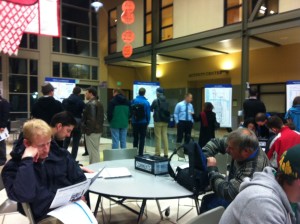 While some attendees were as yet undecided as to which corridor they would support, others were very vocal in their preference. “Corridor D is the highest performing option for infrastructure that is sure to last over 100 years,” says Ballard resident Caelen Ball. Other attendees, like local Lucas Simons, attended the open house to learn more about all of the possible transit routes. “When something costs this much, it is important to consider all of the options,” says Simons.
While some attendees were as yet undecided as to which corridor they would support, others were very vocal in their preference. “Corridor D is the highest performing option for infrastructure that is sure to last over 100 years,” says Ballard resident Caelen Ball. Other attendees, like local Lucas Simons, attended the open house to learn more about all of the possible transit routes. “When something costs this much, it is important to consider all of the options,” says Simons.
Mayor McGinn also attended the open house and discussed the big picture of the study so far. “The work that we are doing in planning here is critical,” says McGinn. McGinn pointed to the combined efforts of both Sound Transit and the City of Seattle in the successful execution of the transit study and mentioned the different characteristics and costs associated with each corridor option. He then pointed to next big challenge in the process as being “how to finance the transit we want.”
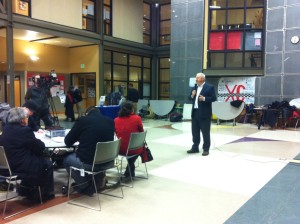 In terms of the next step in the process, after community feedback is gathered from the final open house, a final report with the study findings will be released early next year and the report will go before the Seattle City Council and the Sound Transit Board in the Spring. From there funding options will be investigated and the project will hopefully come to fruition.
In terms of the next step in the process, after community feedback is gathered from the final open house, a final report with the study findings will be released early next year and the report will go before the Seattle City Council and the Sound Transit Board in the Spring. From there funding options will be investigated and the project will hopefully come to fruition.
If you were unable to attend the open house and want to give your feedback click here and complete the online feedback form by December 13.
